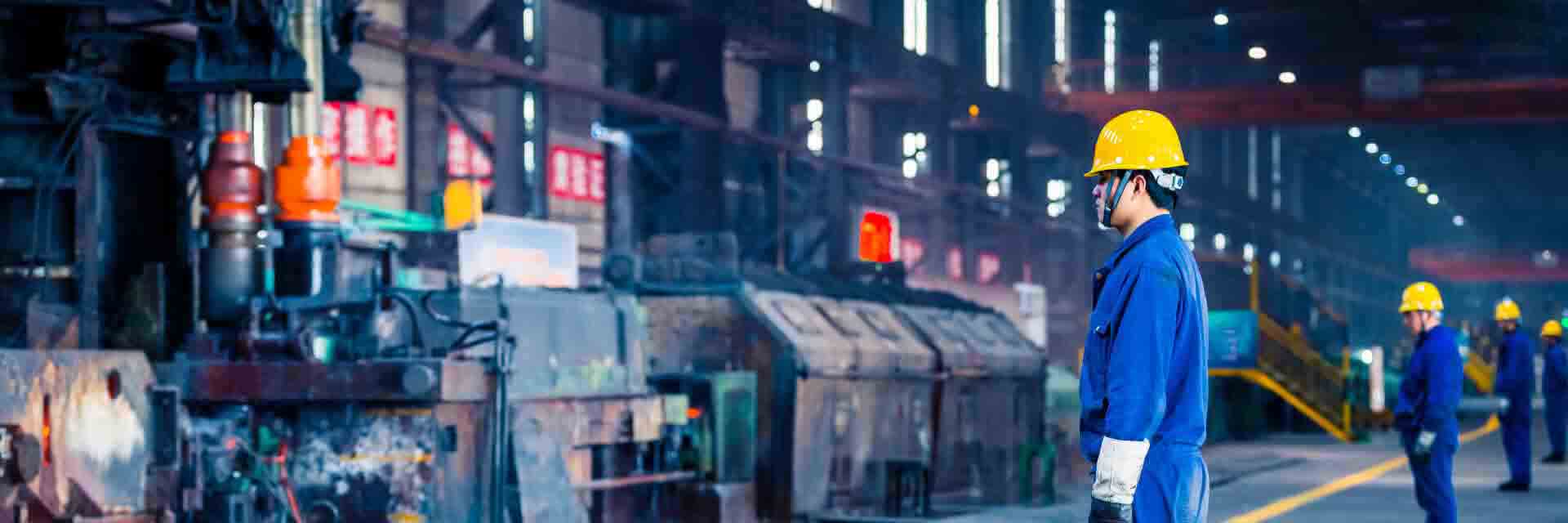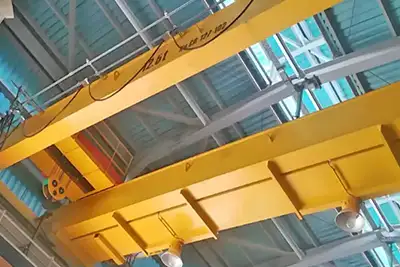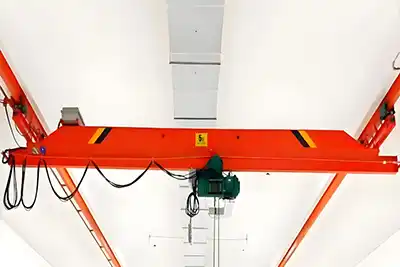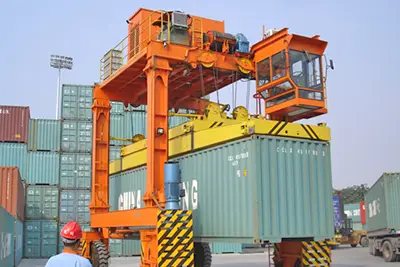Choosing the Right Crane for Steel Billet Handling Overhead Crane
Practical guide to help you compare electromagnetic & mechanical grabs for safe, efficient steel billet lifting and storage. Get billet handling crane!
Introduction
Efficient handling of steel billets is one of the key factors in running a smooth steel manufacturing operation. Billets are heavy, solid steel pieces that are often hot when moved. If they are not handled properly, it can lead to production delays, damage to the billets, and even safety risks for workers.
Overhead cranes are the main equipment used to move billets within a steel mill. These cranes transport billets from the casting area to storage or to the next production step, such as rolling or forging. Because of the weight and sometimes high temperature of billets, cranes need to be strong, reliable, and designed specifically for this type of material handling.
One of the most important choices in setting up billet handling is selecting the right grab system that attaches to the crane. The two main types are electromagnetic grabs and mechanical clamps. Each type has its advantages and limitations depending on your specific billet characteristics and operational needs.
The goal of this guide is to help buyers and plant managers understand the differences between these grab types. By providing clear information on how each option works and what to consider, we want to help you make the best choice. This will improve your plant’s safety, increase handling speed, and reduce equipment wear and maintenance costs.
In short, picking the right overhead crane and grab system is essential for efficient, safe, and cost-effective steel billet handling.
overhead crane for billet handling
Steel Billet Handling Requirements
When choosing an overhead crane and grab for steel billet handling, understanding the billets themselves is the first step. The size, shape, weight, and condition of the billets all influence what kind of crane and grabbing device you’ll need.
Typical Billet Sizes, Shapes, and Weights
Steel billets come in a variety of sizes and shapes, but most common are square or rectangular cross-sections. Their lengths can range from 4 meters up to 12 meters or more, depending on the manufacturing process.
- Common Cross-Sections:
Usually square or rectangular, often around 100mm x 100mm to 180mm x 180mm. - Typical Lengths:
Between 4 to 12 meters, but can be customized. - Weights:
A single billet typically weighs 1 to 5 tons, depending on size and steel grade. - Bundles:
Often, cranes lift multiple billets together. A bundle could weigh from 10 to 40 tons or more.
Impact of Billet Variations on Crane and Grab Selection
Variations in size, weight, and shape can greatly affect which crane and grab system works best:
- Weight and Capacity:
The crane must be rated to lift the maximum bundle weight safely, with an extra safety margin (usually 20-30%). - Shape and Surface:
Square billets with smooth surfaces work well with both mechanical clamps and electromagnets.
However, if billets are irregular, rough, or coated with scale, mechanical clamps often offer a better grip. - Length:
Longer billets require wider grab spans or adjustable clamps to secure the load properly and prevent swinging during lifting. - Bundle Size:
Larger bundles increase the total load and require stronger cranes and grabs designed for wider coverage.
Handling Environments and Temperature Considerations
The environment where billets are handled also plays a role:
- Hot Billets:
Billets can be very hot right after casting, sometimes exceeding 800°C. Cranes and grabs must be designed with heat-resistant materials and components.
Electromagnetic grabs work well for hot billets because they don’t physically clamp the load, reducing damage risk. - Cold Billets:
Stored or cooled billets are handled at room temperature or lower. Electromagnets can lose grip strength on cold or coated billets, making mechanical clamps a safer choice here. - Environmental Factors:
Dust, moisture, and corrosive atmospheres (common in steel mills) require grabs and cranes with durable coatings and sealed electrical parts. - Operation Frequency:
Continuous handling means the crane and grab need to be built for heavy duty use with minimal downtime.
Knowing your billet sizes, weights, and operating environment helps you choose the right crane capacity and grab type. This ensures safe handling, reduces wear and tear, and keeps your operation running smoothly.
Overhead Crane Capacity and Duty Classifications
When selecting an overhead crane for steel billet handling, two of the most important factors to consider are the crane’s lifting capacity and its duty classification. Getting these right ensures your crane can safely and reliably handle the load while meeting the demands of daily operation.
Typical Crane Capacities for Billet Handling
Steel billets vary in size and weight, and are often moved in bundles rather than individually. This affects the crane capacity you need.
- Most overhead cranes used in billet handling have capacities between 10 and 40 tons.
- The capacity depends on the heaviest bundle you need to lift. For example, if your average bundle weighs 25 tons, a crane with at least a 30-ton capacity is advisable.
- Always include a safety margin of 20–30% above your maximum load. This protects against unexpected weight increases or dynamic forces during lifting.
- Consider future growth or changes in your operation that might require heavier lifts — it’s wise to plan ahead.
Understanding Duty Classifications
The term “duty classification” describes how hard and how often a crane will be used. It defines the mechanical strength, electrical system robustness, and maintenance requirements.
Duty classifications range from light use (A1, A2) to very heavy or continuous use (A7, A8).
In steel billet handling, cranes are usually in the A5 to A8 range because the operation involves:
- Frequent starting and stopping of the crane and hoist
- Heavy loads often near maximum capacity
- Harsh conditions like high temperatures, dust, and vibrations
Higher duty classes mean cranes are built with stronger motors, heavier-duty gearboxes, and better braking systems to handle constant, tough work.
Why Matching Crane Capacity and Duty Class Matters
- Safety First: If your crane’s capacity or duty rating is too low, it risks mechanical failure or accidents. Heavy billets and constant use put stress on the crane’s structure and components.
- Reliability and Uptime: Properly rated cranes experience less wear and tear, reducing breakdowns and maintenance. This keeps your mill running smoothly and avoids costly production stops.
- Operational Efficiency: A crane designed for your handling needs lifts loads confidently and operates smoothly, which speeds up material flow. Slow or unreliable cranes create bottlenecks.
- Cost Savings Over Time: Though higher-capacity and duty-rated cranes may cost more upfront, they last longer and require fewer repairs, saving money in the long run.
- Adaptability: A crane sized and rated correctly can handle variations in billet size and weight, and adapt to changes in your production process without major modifications.
Selecting the right overhead crane capacity and duty class is critical for efficient and safe billet handling. Always choose a crane that exceeds your maximum load by a safe margin and matches your operation’s duty cycle. This ensures a reliable, efficient, and long-lasting solution that supports your steel mill’s productivity.
magnetic overhead crane
Electromagnetic Grabs: Features and Applications
How Electromagnetic Grabs Work
Electromagnetic grabs use powerful magnets to lift steel billets. When powered, an electric current creates a magnetic field that holds the billets securely without physically clamping them. Once the power is turned off, the magnetic field disappears, releasing the load.
Advantages of Electromagnetic Grabs
- Fast and Efficient Grip: The magnetic field forms instantly, allowing quick pick-up and release of billets. This speeds up handling and reduces cycle times.
- Minimal Mechanical Wear: Because there are no moving parts gripping the billets, wear and tear on the grab itself is very low. This means less maintenance and longer service life.
- Ideal for Hot Billets: Electromagnetic grabs are well-suited for handling billets immediately after casting when they’re extremely hot (sometimes over 800°C). They avoid damaging the hot surface or altering billet quality.
Limitations to Keep in Mind
- Power Dependency: These grabs require a constant and stable electrical power supply. Any interruption can cause the magnets to lose grip, which is a safety concern.
- Less Effective on Coated or Cold Billets: If billets are covered in scale, rust, or are cold, the magnetic force can weaken. This makes the grip less reliable and increases the risk of slipping.
- Not Suitable for Non-Ferrous Materials: Electromagnetic grabs only work with ferrous metals like steel. They cannot lift non-magnetic materials.
Ideal Use Cases for Electromagnetic Grabs
- Plants handling hot billets straight from casting lines.
- Operations requiring fast and continuous handling with minimal downtime.
- Situations where minimal mechanical wear on the grab is desired to reduce maintenance.
- Facilities with a reliable power supply and safety systems to prevent accidental drops.
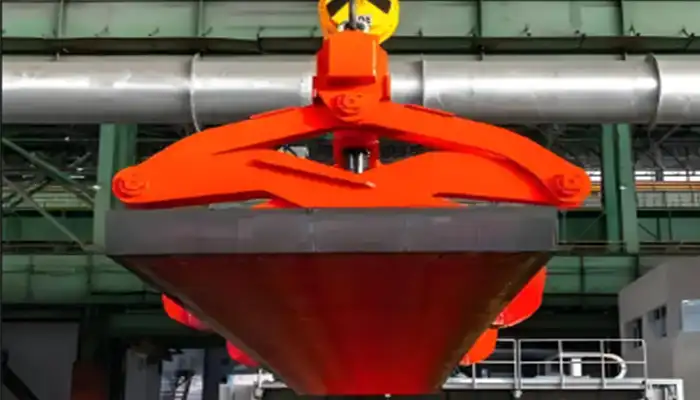
Mechanical Clamp Grabs: Features and Applications
How Mechanical Clamp Grabs Work
Mechanical clamp grabs use physical clamps or jaws to grip billets tightly. These clamps open and close around the billets using hydraulic, pneumatic, or mechanical mechanisms. The grab holds the billet securely by applying pressure.
Advantages of Mechanical Clamp Grabs
- Reliable Grip on Varied Shapes: Mechanical clamps work well with billets of different shapes, sizes, and surface conditions, including irregular or rough billets.
- Effective for Cold and Coated Billets: Unlike magnets, clamps maintain a strong grip even on cold billets or those covered with scale, rust, or oil.
- Less Dependent on Power: Clamps can work with hydraulic or pneumatic power sources, which may be more stable in some environments than electric power.
Limitations to Consider
- Mechanical Wear: Moving parts like jaws, cylinders, and linkages experience wear and require regular inspection, lubrication, and replacement.
- Higher Maintenance Needs: The grab’s mechanical components need routine maintenance to avoid failure and ensure safety.
- Slower Operation: Opening and closing clamps take longer than the instant grip of magnets, which can slow down handling cycles.
- Potential for Billet Damage: If not properly adjusted, mechanical clamps can leave marks or dents on billet surfaces.
Ideal Use Cases for Mechanical Clamp Grabs
- Handling cold billets or those with rough, coated surfaces.
- Operations with variable billet sizes and shapes requiring adjustable or custom clamp designs.
- Facilities where power supply is unstable or electric safety concerns exist.
- Situations where billet surface protection is less critical, or mechanical marking can be tolerated.
Both electromagnetic and mechanical clamp grabs have their strengths and weaknesses. Electromagnetic grabs excel in fast, low-maintenance handling of hot billets but depend heavily on power supply and billet surface condition. Mechanical clamps offer reliable gripping across varied billet types and conditions but require more maintenance and operate slower.
Choosing between them depends on your specific billet properties, handling environment, and operational priorities.
Comparative Analysis: Electromagnetic vs. Mechanical Grabs
Choosing between electromagnetic and mechanical grabs requires understanding how they perform across key factors like grip reliability, maintenance, speed, and more. Here’s a side-by-side look to help you decide which fits your billet handling needs best.
Grip Reliability and Safety
Electromagnetic Grabs:
- Provide a firm, uniform grip on clean, hot, and smooth steel billets.
- Grip can weaken if billets are cold, rusty, or coated with scale, increasing the risk of slips.
- Depend on a continuous power supply; any power failure means instant loss of grip, so backup power or safety catches are crucial.
Mechanical Clamp Grabs:
- Offer a strong, positive mechanical grip on a wide variety of billet shapes and surface conditions.
- Work well on cold and coated billets where electromagnets struggle.
- Grip remains secure even without electrical power, enhancing safety in unstable power environments.
Maintenance and Operational Costs
Electromagnetic Grabs:
- Fewer moving parts lead to lower mechanical wear and reduced routine maintenance.
- Electrical components (coils, insulation) require periodic inspection but generally have longer service life.
- Operating costs include continuous power consumption while gripping billets.
Mechanical Clamp Grabs:
- Mechanical parts such as jaws, hydraulic cylinders, and linkages experience wear and require regular maintenance, replacement, and lubrication.
- Higher maintenance labor and parts costs.
- May have lower continuous power consumption if using hydraulics or pneumatics, depending on system design.
Handling Speed and Efficiency
Electromagnetic Grabs:
- Fast engagement and release speeds improve handling cycle times.
- Suitable for high-volume operations needing rapid billet transfers.
Mechanical Clamp Grabs:
- Slower grip and release times due to mechanical movement.
- May slightly reduce throughput in fast-paced operations but offer more control in complex lifts.
Suitability Based on Billet Characteristics
Temperature:
- Electromagnetic grabs are excellent for handling hot billets, as they do not physically clamp and risk deforming the billet.
- Mechanical clamps are better suited for cold billets or billets stored at room temperature.
Surface Condition:
- Electromagnets perform best on clean, smooth billets with minimal scale or coating.
- Mechanical clamps handle rough, rusty, or coated billets reliably.
Shape and Size:
- Mechanical clamps can adjust to irregular billet shapes and sizes better than fixed magnetic fields.
Energy Consumption and Environmental Factors
Electromagnetic Grabs:
- Require continuous electrical power during load holding, leading to higher energy use.
- Electrical systems must be well-maintained to prevent overheating and insulation failure.
Mechanical Clamp Grabs:
- Typically consume energy only during clamp movement (opening/closing), potentially reducing energy costs.
- Hydraulic or pneumatic systems may have environmental concerns related to fluid leaks or compressor noise.
| Factor | Electromagnetic Grabs | Mechanical Clamp Grabs |
|---|---|---|
| Grip Reliability & Safety | Excellent on hot, clean billets; power-dependent | Reliable on varied surfaces; mechanical grip |
| Maintenance | Low mechanical wear; periodic electrical checks | Higher mechanical wear; regular upkeep needed |
| Handling Speed | Fast, ideal for high throughput | Slower grip/release times |
| Billet Suitability | Best for hot, smooth billets | Best for cold, coated, irregular billets |
| Energy Consumption | Continuous power needed during grip | Energy used only during clamp action |
| Environmental Concerns | Electrical system heat, insulation | Hydraulic/pneumatic fluid and noise |
Your choice depends heavily on your specific billet types, plant environment, and operational priorities. If speed and minimal maintenance matter most and you handle hot billets, electromagnetic grabs may be the way to go. But if you work with colder, coated billets or need guaranteed grip under unstable power, mechanical clamps often prove more reliable.
Key Factors in Selecting the Right Crane and Grab System
Selecting the ideal crane and grab system requires careful consideration of your plant’s specific conditions, operational needs, budget, and future plans. Below are the key factors to keep in mind.
Operational Environment and Handling Frequency
Your working conditions and how often you handle billets will affect the choice of crane and grab.
- Workplace Conditions:
Consider whether your facility is indoors, outdoors, or partially exposed. Environmental factors like heat, dust, moisture, or corrosive substances impact equipment durability and safety. - Handling Frequency:
How often the crane operates daily matters. High-frequency, continuous use demands heavy-duty, reliable equipment designed for frequent load cycles. Occasional use allows for lighter-duty systems that save costs. - Mechanical Stress:
Frequent starts and stops increase wear on components, so choose cranes and grabs designed for your usage patterns to reduce maintenance and downtime.
Power Availability and Safety Considerations
The type and reliability of your power supply, plus safety requirements, are critical in selecting the right system.
- Electrical Power Stability:
Assess whether your plant has a stable and adequate power supply. Electromagnetic grabs need continuous electricity to maintain a safe grip, while mechanical clamps can often run on hydraulic or pneumatic power. - Safety Features:
Confirm the availability of safety systems such as emergency stops, backup power supplies, and safety catches. These features help prevent accidents and comply with regulations, especially in hazardous environments.
Budget Constraints and Lifecycle Costs
Balancing upfront investment with long-term expenses will help you choose a cost-effective solution.
- Initial vs. Ongoing Costs:
Think beyond the purchase price. Electromagnetic grabs may use more energy but require less mechanical maintenance, while mechanical clamps might need more upkeep but consume less power. - Parts and Service Access:
Ensure spare parts are readily available and local service is accessible to minimize repair time and cost. Don’t forget to check supplier warranties, training, and support options.
Customization and Future Scalability
Planning for your current and future needs ensures your investment remains valuable over time.
- Tailored Design:
Custom grabs or crane configurations can optimize billet handling for your unique sizes, weights, and processes, improving efficiency and reducing damage. - Growth Flexibility:
Consider whether your plant will increase output or handle different billets later. Systems that can scale or be modified help avoid costly replacements.
Quick Checklist for Your Selection
- Environmental Suitability: Is your crane system designed for heat, dust, or outdoor conditions?
- Usage Intensity: How many hours daily will your crane work?
- Power Source: Do you have a reliable electrical supply, or would hydraulic/pneumatic systems be better?
- Budget Planning: What is your total investment, including operation and maintenance?
- Customization Needs: Can the system be tailored and upgraded easily?
- Safety Compliance: Are necessary safety features and regulations addressed?
Practical Buyer Tips for Choosing Your Crane and Grab System
Buying an overhead crane and grab system for steel billet handling is a big investment. To make sure you get the best value and a reliable solution, here are some key tips every buyer should follow.
Verify Manufacturer Certifications and Quality Standards
Before finalizing your purchase, it’s crucial to check the credibility of the manufacturer.
- Certifications Matter:
Look for manufacturers with recognized industry certifications like CE, ISO, or other national safety and quality marks. These confirm that the equipment meets rigorous safety, quality, and performance standards. - Third-Party Inspections:
Ask if the equipment has been tested or inspected by independent third parties. This adds an extra layer of assurance that your crane and grab meet specifications. - Compliance with Local Regulations:
Ensure the crane system complies with your country’s safety and operational regulations. Non-compliance can lead to costly fines or unsafe conditions.
Assess Maintenance Support and Spare Parts Availability
Reliable ongoing support can save you time and money down the road.
- Local Service Centers:
Confirm if the manufacturer or their partners have local service centers or authorized technicians near your plant. Quick support minimizes downtime. - Spare Parts Stock:
Ask about the availability of critical spare parts. Long lead times or hard-to-get parts can delay repairs and impact production. - Maintenance Programs:
Some manufacturers offer preventive maintenance contracts or training programs. These services help extend equipment life and keep operations running smoothly.
Request Case Studies or References for Similar Applications
Seeing how a crane system performs in real-life conditions can build your confidence in the product.
- Ask for Case Studies:
Request examples of projects similar to yours, especially handling steel billets or similar materials. This shows the manufacturer’s experience and capability. - Check Customer References:
Don’t hesitate to contact previous clients to ask about their experience with the crane, grab, and after-sales support. Honest feedback helps avoid surprises. - Look for Industry Experience:
Manufacturers with extensive experience in steel mills or billet handling are more likely to understand your specific needs.
Plan for Operator Training and Safety Protocols
Even the best equipment needs skilled operators and clear safety rules to perform well.
- Operator Training:
Ensure the manufacturer or supplier offers training programs for crane operators. Proper training reduces accidents, equipment damage, and improves efficiency. - Safety Procedures:
Work with your team to develop or update safety protocols for handling billets with overhead cranes. Include emergency response plans, daily inspection routines, and load handling best practices. - Regular Refresher Courses:
Safety and operational training shouldn’t be one-time. Schedule regular refresher courses to keep skills sharp and updated on any new equipment features.

